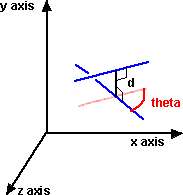The intersection of two lines is a point. However, this only applies if the lines intersect, otherwise the intersection is null.
In Two Dimensions
In two dimensions the lines will intersect if they are not parallel, that is, if they have a different slope.
- if the lines are the same the intersection is the whole line.
- if the lines are parallel but not the same then the intersection is null.
- if the lines are neither the same or parallel then the intersection is a point.
In Three or more Dimensions
When lines are in 3 dimensions it is possible that the lines do not intersect, being in two different planes.

We can use dual numbers to represent skew lines as explained here.
The relationship between the lines is represented by the dual number:
theta + d D
where:
- theta is the angle between the lines (in radians)
- d is the distance between the lines
- D is the dual operator
if theta=0 then the lines are parallel
if d=0 then the lines intersect
Meet
For a wider discussion of intersection of 2D shapes see this page.
